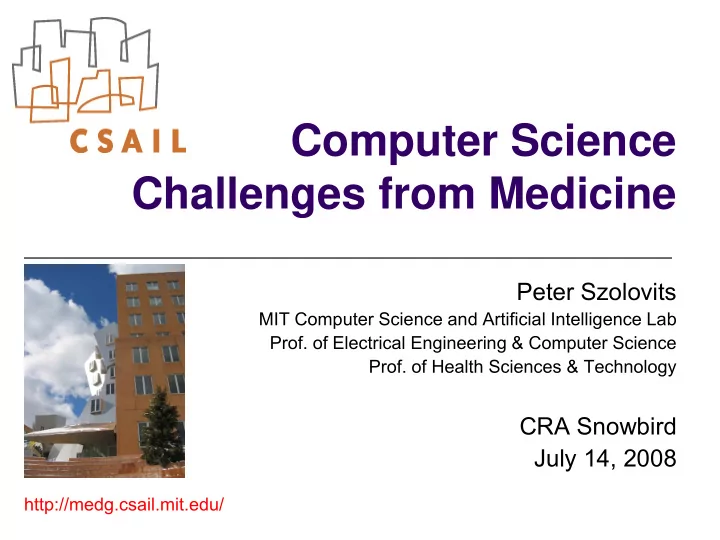

Computer Science Challenges from Medicine Peter Szolovits MIT Computer Science and Artificial Intelligence Lab Prof. of Electrical Engineering & Computer Science Prof. of Health Sciences & Technology CRA Snowbird July 14, 2008 http://medg.csail.mit.edu/
US Health Care is Broken � IOM: 48-98,000 “unnecessary” deaths/year � 45M uninsured � Emergency Room as primary care � Poor communication among providers � Repeat tests, incoherent care (no continuity), delays � Spending ~17% of GDP, and growing � GM cars contain more health care than steel � BTW, education spending ~8-9% !!! � Poor IT deployment and use � Most IT adoption for “low-hanging fruit”, e.g., billing � Low investment levels � Major systems tend to “melt down” (e.g., Kaiser, NHS) 7/23/2008 Peter Szolovits, MIT 2
NAS/NRC/CSTB Study (in progress; comments mine, not committee’s!) � Challenges in CS ∩ IT ∩ healthcare � Site-visit based study, led by Bill Stead (Vanderbilt) � Fragmented data from heterogeneous systems � Documentation of what has been done, not mediation of what is being done � UI’s look like paper predecessors � Very rare decision support/evidence based advice � Unclear, ad hoc , complex processes � Not recorded, not analyzed � Frequent interruptions � Speed is paramount for users 7/23/2008 Peter Szolovits, MIT 3
Points of Leverage � Policy � Insurance � Incentives � Technology � Improved collection, handling & use of data � Communication and workflow � Decision Support � Privacy and Confidentiality � Transformational Opportunities � Patient involvement & control � Research integrated with care � Healthcare as a system (IOM+NAE Report Building a Better Delivery System: A New Engineering/Health Care Partnership , 2005) � 7/23/2008 Peter Szolovits, MIT 4
Data: Examples of the Good � MIMIC II: 30,000 ICU patients @ BIDMC � Signals (~4000), numerics, notes, labs, pharma, HIS � Harvard Crimson � Save all blood samples, available for studies � Gene Expression Omnibus (GEO) � All “raw” data from NIH-supported genomic experiments � Available for data re-use 7/23/2008 Peter Szolovits, MIT 5
Data: The Bad � Poor interoperability � How to fix? � Standards � HL7 CDA, CCR, ASN12, DICOM, LOINC, ICD, SNOMED… � Office of National Coordinator for Healthcare AHIC, HITSP, CCHIT, HISPC, … � � “Semantic Web”--loosely coupled declarative data 7/23/2008 Peter Szolovits, MIT 6
Data: The Opportunity � Improved acquisition methods � Intelligent Listening --new modalities such as speech � Aware examining room --gestures, seeing & interpreting actions � Walking ICU --wearable real-time instrumentation � Lifelong, patient-controlled records � E.g., indivohealth.org, MS HealthVault, Google Health 7/23/2008 Peter Szolovits, MIT 7
Decision Support � Models of disease and of healthcare � “Expert systems”--rules or patterns � Statistical predictive models � Machine learning/data mining ( neo-statistics ) � Qualitative “causal” models � Differential equation models of pathophysiology � Integration with workflow � E.g., CPOE � Built-in follow-up actions with each action � Support patients, not just providers 7/23/2008 Peter Szolovits, MIT 8
Patient Control � Who cares most about your health? � Who is “on the spot” for all events & decisions? � Who knows your preferences best? � Who is willing to work without payment? So, why not put you in charge of your continuity of care? 7/23/2008 Peter Szolovits, MIT 9
Desired Functionality (from 1994 Guardian Angel proposal) � Patient-owned life-long individual record: all medical conditions, care, preferences, …; allows individual to collect data on own medically- relevant experiences � Personal interface to health-care information systems: hospital, lab, clinic, billing, … � Individualized medical encyclopedia : explains results and plans to patient � Communication interface with care team � Permit unobtrusive continuous monitoring of relevant health-related activities and conditions � Decision support for the patient and caretakers 7/23/2008
Integrating Research with Care Research Health Episode Schedule Status Authorization Membership Activation Mgt. Visit Refer Activation Plan Health Health Mgt. Desig Record Mgt. Team n Self Care Assess Measure Community Care Care Plan Evaluate Team Accoun t Biomedicine Discharge Act Dismiss Clinical Care Processes Rad Surgery Lab Int. Diagram from David Margulies Pharm Med 7/23/2008 Peter Szolovits, MIT 11
I2b2: Integrating Information from Bench to Bedside � Phenotype = Genotype + Environment � We’re getting very good at measuring G � P is represented by clinical history � E.g., Scott Weiss’ asthma study � Use Partners Health Care RPDR (Research Patient Data Repository) to select especially poorly-responding asthma patients � Collect genomic data � Find predictive relationships 7/23/2008 Peter Szolovits, MIT 12
Privacy and Confidentiality � Improving trust � Transparency � Patient control of access and dissemination � Cryptographic framework using digital signatures � Allows separation of possession from authenticity � Practical problem: authenticating patients, providers � Separating individuality from identity � De-identification � Tabular data: k -anonymity, geographic fuzz � Text: NLP models for finding PHI 7/23/2008 Peter Szolovits, MIT 13
Recommend
More recommend